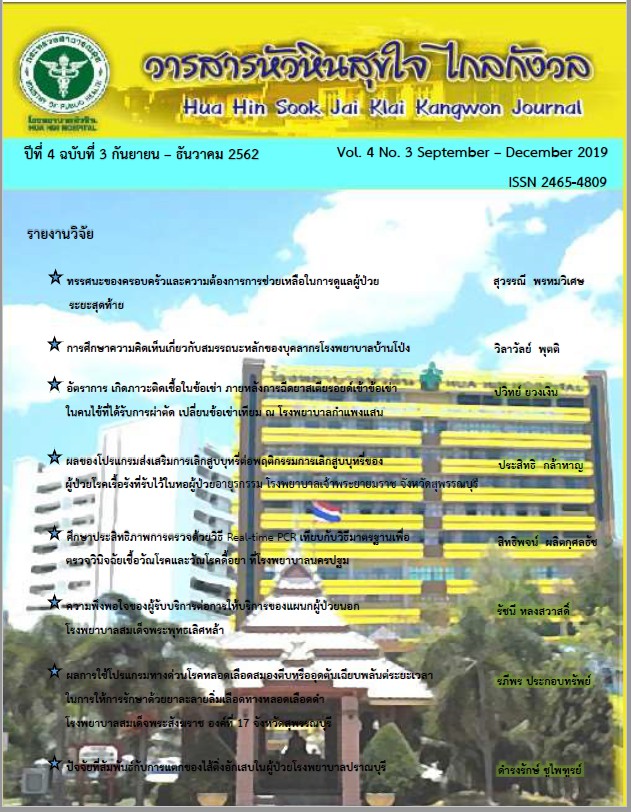Effects of Using Acute Stroke Fast Track Program on Door to needle Time in Somdejprasangkharach 17th Hospital, Suphanburi
Keywords:
Program, Stroke fast track, Door to needle timeAbstract
This quasi-experimental research aimed to : compared door to needle time, both before and after the use of the stroke fast tract program. The sample was composed of 52 patients with ischemic stroke who received thrombolytic agents and were admitted at Somdejprasangkharach 17th Hospital from July, 2014 to December, 2017. Sample was 22 patients before and 30 patients after the used of the stroke fast track program. Purposive population was used the Stroke fast track program was developed in 2017. The system theory was used as a conceptual framework for this study. Data were collected by using 3 instruments, including a personal information questionnaire ,the assessment of stroke form and the stroke fast track care map form. The Stroke fast track program that tested for its content validity by three experts. Data were analyzed using independent t – test.
The finding revealed that after using the program: 1) the mean score of door to needle time ( =58.03minute, SD=8.73) was significantly higher than those before the program =110.86 minute, (SD=21.32) (p<.001).
References
2. สำนักงานพัฒนานโยบายสุขภาพระหว่างประเทศ. รายงานภาระโรคและการบาดเจ็บของประชากรไทย พ.ศ.2556. นนทบุรี: เดอะ กราฟิโก ซิสเต็มส์ จำกัด; 2558. หน้า 15-19.
3. นิจศรี ชาญณรงค์. การจัดระบบดูแลผู้ป่วยโรคหลอดเลือดสมองเฉียบพลันและต่อเนื่องใน สถานพยาบาล คณะแพทยศาสตร์ โรงพยาบาลจุฬาลงกรณ์มหาวิทยาลัย/สำนักงานกองทุนสนับสนุนการวิจัย (สกว.); 2550. PDG4830207
4. สมชาย โตวณะบุตร, ทัศนีย์ ตันติฤทธิศักดิ์. แนวทางการรักษาโรคหลอดเลือดสมองตีบและอุดตันด้วยการฉีดยาละลายลิ่มเลือดทางหลอดเลือดดํา. กรุงเทพ; 2549.
5. สมศักดิ์ เทียมเก่า.(2558). การพัฒนาเครือข่ายโรคหลอดเลือดสมองภาคอีสาน. วารสารสมาคม
โรคหลอดเลือดสมองไทย 2558; 14: 3-13.
6. ทัศนีย์ ตันติฤทธิศักดิ์ (บรรณาธิการ). สถาบันประสาทวิทยา. แนวทางการรักษาโรคหลอดเลือดสมองตีบหรืออุดตันสําหรับแพทย์ ฉบับปรับปรุงครั้งที่ 2 .กรุงเทพ; 2550.
7. สายสมร บริสุทธิ์. Assessment and monitoring in Stroke fast track. เอกสารประกอบการประชุมวิชาการพยาบาลเครือข่ายโรคหลอดเลือดสมอง; 2552.
8. พรภัทร ธรรมสโรชและสมบัติ มุ่งทวีพงษา. การพัฒนาเครือข่ายการส่งต่อผู้ป่วยโรคหลอดเลือดสมอง มหาวิทยาลัยธรรมศาสตร์ (Thammasat Stroke Network).J Thai StrokeSoc, 2558; 14: 14-22.
9. สุพัฒนา อรุณไพร. การพัฒนาแนวปฏิบัติการพยาบาลทางคลินิกสำหรับผู้สูงอายุโรคหลอดเลือดสมองระยะเฉียบพลัน แผนกฉุกเฉิน โรงพยาบาลกมลาไสย จังหวัดกาฬสินธุ์. คณะพยาบาลศาสตร์ มหาวิทยาลัยบูรพา; 2556.
10. ธารารัตน์ ส่งสิทธิกุล และ อรวรรณ อนามัย. การพัฒนาระบบบริการพยาบาลผู้ป่วยโรคหลอดเลือดสมองตีบหรืออุดตันที่รักษาด้วยยาละลายลิ่มเลือด โรงพยาบาลราชบุรี. วารสารกระทรวงสาธารณสุข 2559; 2: 142-53.
Downloads
Published
How to Cite
Issue
Section
License
บทความที่ได้รับการตีพิมพ์ในวารสารหัวหินเวชสาร เป็นลิขสิทธิ์ของโรงพยาบาลหัวหิน
บทความที่ลงพิมพ์ใน วารสารหัวหินเวชสาร ถือว่าเป็นความเห็นส่วนตัวของผู้เขียนคณะบรรณาธิการไม่จำเป็นต้องเห็นด้วย ผู้เขียนต้องรับผิดชอบต่อบทความของตนเอง







